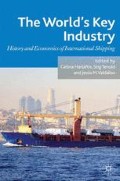Abstract
The development of maritime history as a specialized field of research is an impressive testament to the founders of the International Maritime Economic History Association.1 Skip Fischer’s own publications, together with his relentless efforts as editor of the International Journal of Maritime History, have contributed significantly to placing seaborne transport at the centre of the international economic history of the nineteenth century. As a result of the collective efforts made in the field since the 1970s, most economists, economic historians and general historians now recognize the pivotal role played by the maritime sector in fostering a truly global economy before World War One (WWI).
Access this chapter
Tax calculation will be finalised at checkout
Purchases are for personal use only
Preview
Unable to display preview. Download preview PDF.
Notes
For general historiographies of the field of maritime history, see F. Broeze (ed.) (1995) Maritime History at the Crossroads: A Critical Review of Recent Historiography ( St John’s: IMEHA );
L. Johnman and H. Murphy (2007), ‘Maritime and Business History in Britain: Past, Present and Future?’ International Journal of Maritime History XIX, no. 1, pp. 239–70;
G. Harlaftis (2010) ‘Maritime History or the History of Thalassa’, in G. Harlaftis, N. Karapidakis, K. Sbonias and V. Vaiopoulos (eds) The New Ways of History. Developments in Historiography ( London: Tauris Academic Studies ).
R. Findlay and K. H. O’Rourke (2007) Power and Plenty: Trade, War, and the World Economy in the Second Millennium ( Princeton, NJ: Princeton University Press ), p. 502.
M. Stopford (2009) Maritime Economics ( London: Routledge ), p. 35.
P. Lorange (2009) Shipping Strategy: Innovating for Success ( New York: Cambridge University Press ), p. 82.
S. I. S. Mohammed and J. G. Williamson (2004) ‘Freight Rates and Productivity Gains in British Tramp Shipping 1869–1950’, Explorations in Economic History, vol. 41, no. 2, p. 201.
K. G. Persson (2010) An Economic History of Europe: Knowledge, Institutions and Growth, 600 to the Present ( Cambridge: Cambridge University Press ), p. 225.
Y. Kaukiainen (2006) ‘Journey Costs, Terminal Costs and Ocean Tramp Freights: How the Price of Distance Declined from the 1870s to 2000’, International Journal of Maritime History, vol. XVIII, no. 2, p. 17.
Kaukiainen, Y. (2009) ‘Growth, Diversification and Globalization: Main Trends in International Shipping since 1850’, in L. R. Fischer and E. Lange (eds) International Merchant Shipping in the Nineteenth and Twentieth Centuries: The Comparative Dimension ( St John’s: IMEHA ), p. 41–2.
For the original statement on the freight factor, see D. North (1958) ‘Ocean Freight Rates and Economic Development 1750–1913’, The Journal of Economic History, vol. 18, no. 4, p. 538.
K. G. Persson (2004) ‘Mind the Gap! Transport Costs and Price Convergence in the 19th Century Atlantic Economy’, European Review of Economic History, vol. 8, issue 2, p. 128.
These figures are taken from Y. Kaukiainen (2009) ‘The Container Revolution and Liner Freights’, International Journal of Maritime History, vol. XXI, no. 2, p. 44.
E. D. Næss (1977) Autobiography of a Shipping Man ( Colchester: Seatrade Publications ), p. 118.
K. Ilner (2009) Jacob Stolt-Nielsen: En Gründer ( Bergen: Vigmostad & Bjørke ), pp. 79–82.
A. Thowsen and S. Tenold (2006) Odfjell ( Bergen: Odfjell ASA ), pp. 305–9.
S. Tenold and K. O. Aarbu (2012) ‘Little Man, What Now? Company Deaths in Norwegian Shipping, 1960–1980’, in L. R. Fischer and E. Lange (eds), New Directions in Norwegian Maritime History, Research in Maritime History ( St John’s: IMEHA ).
Estimates taken from S. Tenold (2010) ‘So Nice in Niches: Specialisation Strategies in Norwegian Shipping, 1960–1977’, International Journal of Maritime History, vol. XXII, no. 1, p. 66.
Editor information
Editors and Affiliations
Copyright information
© 2012 Espen Ekberg, Even Lange and Eivind Merok
About this chapter
Cite this chapter
Ekberg, E., Lange, E., Merok, E. (2012). Building the Networks of Trade: Perspectives on Twentieth-Century Maritime History. In: Harlaftis, G., Tenold, S., Valdaliso, J.M. (eds) The World’s Key Industry. Palgrave Macmillan, London. https://doi.org/10.1057/9781137003751_6
Download citation
DOI: https://doi.org/10.1057/9781137003751_6
Publisher Name: Palgrave Macmillan, London
Print ISBN: 978-1-349-35029-2
Online ISBN: 978-1-137-00375-1
eBook Packages: Palgrave Economics & Finance CollectionEconomics and Finance (R0)

